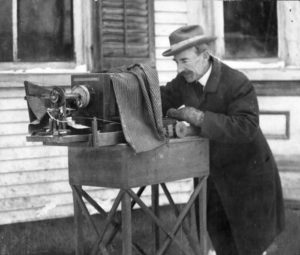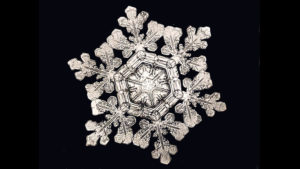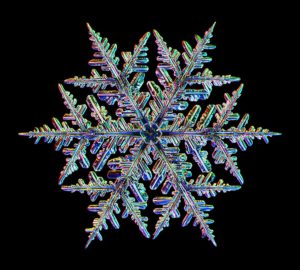Snowflakes are tiny works of art, and the science of snowflake photography gives us a unique insight to that world. The man who developed snowflake photography was Wilson Alwyn Bentley, known in his later years as Snowflake Bentley. Born in 1865 in Jericho, Vermont, Bentley’s research of snow and weather patterns started as a teenager, studying snowflakes under a microscope on his parents’ farm. He drew sketch after sketch of his snowflakes, but when he stumbled upon information of microscope photography, he convinced his father, who was practical to a fault, to purchase a camera with the appropriate equipment for his next endeavor.

It would take Bentley more than a year to find success. The ice crystals would melt quickly, and the photo developing process took a lot of time and effort, especially considering that Bentley was a newcomer to photography. After much trial and error, Bentley had success on February 15, 1885 when he got his first clear image, also known as a photomicrograph. He is quoted as saying “The day that I developed the first negative made by this method, and found it good, I felt almost like falling on my knees beside that apparatus and worshiping it! It was the greatest moment of my life.” Because of his lack of education, Bentley felt his contributions were unworthy of note. Eventually, he met a local professor, who convinced him to submit his first article “A Study of Snow Crystals,” which was published in 1898 in Popular Scientific Monthly. This opened to floodgates, and soon he was publishing articles and traveling the country to give presentations.
Even living in snowy New England, he couldn’t work with snowflakes year-round. He eventually expanded his studies to include other precipitation, including rainfall, mist, and dew, but snow remained his passion. In 1931, he published his life’s work Snow Crystals. This book included almost 2,500 photomicrographs of snowflakes. If you’re interested in seeing Bentley’s work, you can see some of his photomicrographs through the Smithsonian’s online collections, or you find a copy of Snow Crystals at the Science Library. Later that year, Bentley caught pneumonia and passed away at home on December 23rd, 1931.

Bentley created his photomicrographs by capturing the snowflakes on white velvet, then scratching the emulsion off the plate to create the back background. This allowed Bentley to edit out non-symmetrical parts, which contributed to the myth that all snowflakes are completely symmetrical. Our current technology allows for more accurate images of snowflakes. With a willingness to stand outside and a DSLR camera (which you can check out from our tool library), and a macro lens, you too can take your own stunning snowflake photographs! If you follow photographer Craig Goodwin’s advice, the process of snowflake photography hasn’t changed much from Bentley’s time. If you want to read more about Goodwin’s process, you can find his blog post here. If you’re not a photographer, or aren’t interested in sitting outside to catch snowflakes, you can see some great flakes in The Art of the Snowflake: a photograph album by Kenneth Libbrecht, available here at the Engineering Library.

Works Cited
Goodwin, C. (2019, March 2). How to Photograph Snowflakes (and Blow Your Mind). Craig Goodwin Photography. https://www.craiggoodwin.com/blog/2019/2/21/how-to-photograph-snowflakes
Jericho Historical Society. (n.d.). Snowflake Bentley. Snowflake Bentley. https://snowflakebentley.com/
Jones, P. A. (2017, December 23). Wilson A. Bentley: The Man Who Photographed Snowflakes. Mental Floss. https://www.mentalfloss.com/article/89924/wilson-bentley-man-who-photographed-snowflakes
Smithsonian Institution. (2021, December 20). How do you photograph a single snowflake? https://www.si.edu/stories/how-do-you-photograph-single-snowflake